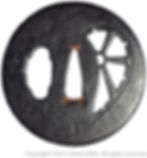(鍔ギャラリー⑥) Tsuba Gallery #6




Kanton Daisho Tsuba (広東大小鐔)
Japanese Title: 双龍唐草図大小鐔
Material: Iron (tetsu 鉄)
Age: Late Edo Period (江戸時代後期)
Size: 大(Dai): 6.5 cm X 6.8 cm, 5 mm at the rim, 小(Shō): 6.0 cm X 6.4 cm
Signature: Mumei (無銘)
Shape: Tatemaru-gata (竪丸形)
Surface Finish: Migaki-ji (磨地)
Attachment: Daisho Tsuba Wooden Storage Box
This is a matching set of handguards (tsuba 鐔) one larger (dai 大) and one smaller (shō 小) each made of well forged iron (tetsu 鉄). The design is that of twin Chinese style dragons carved in the background of a complex vine network (soryu-karakusa zu 双龍唐草図). This popular design was favored by artists working in the seaport city of Nagasaki (長崎) in Hizen Province (肥前國) but later spread to other areas of Japan due to its popularity. The Hizen artists were heavily influenced by Sino-Tibetan aesthetics imported into Japan via merchants from Kanton (広東) a southeastern region of China with a major seaport.
The condition, fine detail, and three-dimensionality of the design on both tsuba is remarkable. Imported iron brought in mass through the international seaport of Nagasaki by the Dutch might have been used to forge the base plates of this tsuba set. The quality of the deeply undercut carving and conventional shape of the (seppa-dai 切羽台) and accessory holes (ryōhitsu-ana 両櫃穴) indicates that the set was made in Japan by the Yagami (矢上) School around the time of the late Edo Period (circa ~1770-1868 CE).
Provenance: David Bond Collection




Sandai Yamakichibei Tsuba (三代山吉兵鐔)
Japanese Title: 片輪車文透鐔 (katawa-kuruma no mon sukashi tsuba)
Material: Iron (tetsu 鉄)
Age: Kanbun (寛文) Era - Genroku (元禄) Era
Size: 7.6 cm X 7.7 cm, 4.2 mm at rim
Signature: Yamakichibei (山吉兵)
Shape: Maru gata (丸形)
Surface Finish: Tsuchime-ji (槌目地)
Attachment: NBTHK Tokubetsu Hozon Paper
This is a forged iron (tetsu 鉄) hand guard (tsuba 鐔). The overall shape of the tsuba is round (maru-gata 丸形). The rim tsuba has a wonderful round shape (maru-mimi 丸耳). The surface of the tsuba has a fine hammered texture (tsuchime-ji 槌目地) that feels great in the hand. The positive openwork (ji-sukashi 地透) design is of a single wheel of a cart (katawa-kuruma 片輪車).
This tsuba is an exceptional example of the third generation Yamakichibei (山吉兵) work who was based in the castle city of Nagoya (名古屋) of Owari Province (尾張國) also known as Bishū (尾州) during the Kanbun (寛文) to the Genroku (元禄) eras (1661-1704). Yamakichibei along with Fukui Jizaemon and Toda Hikozaemon are considered the three great masters of the Genroku Era. The appraisal paper issued on February 24, 2017 (tokubetsu hozon tōsōgu kanteisho 特別保存刀装具鑑定書) by the (Nihon Bijutsu Hozon Kyokai 日本美術刀剣保存協會) (NBTHK), Society of the Preservation of the Japanese Art Sword designating the tsuba to be of exceptional quality, authentic, and worthy of historical preservation during its formal examination (shinsa 審査). This tsuba was directly attributed to be the work of third generation (sandai 三代) Yamakichibei master by the NBTHK.
The tsuba was published in the old Japanese book of One Hundred Tsuba Designs (hyaku tsuba no zu 百鐔之図). This early book used the rubbing (oshigata 押形) method of tracing the outline of the tsuba followed by the reproduction of the details of the designs by rubbing charcoal on thin rice paper over the surface of the tsuba. The publication date of this book is not clear but likely dates from the Meiji Period (明治時代) 1868-1912 CE before the widespread use of photography.
Provenance: Eric Molinier Collection




Heianjō Tsuba (平安城鐔)
Japanese Title: ??
Material: Iron (tetsu 鉄)
Age: Mid Edo Period (江戸時代中期)
Size: 8.5 cm X 8.6 cm, 4.5 mm at rim, 5.0 mm at seppa-dai.
Signature: Mumei (無銘)
Shape: Maru-gata (丸形)
Surface Finish: Migaki-ji (磨地)
Attachment: None
This is a large hand guard (tsuba 鐔) likely made for a long sword (katana 刀). It is made of forged iron (tetsu 鉄). The openwork design is made of four pentagons. The edge of the tsuba and around the openwork design is decorated with flat inlays (hira-zōgan 平象嵌) of brass done in a woven rope design (nawame 縄目). The surface of the tsuba on both sides is additionally embellished with a vine and leaf pattern also done using flat inlays of brass. The rim of the tsuba has a rounded square shape (kaku-mimi koniku 角耳小肉). The plate of the tsuba is thinnest at the rim and thickens gradually as you move toward the center (seppa-dai 切羽台).
Provenance: Charlie Foos Collection
